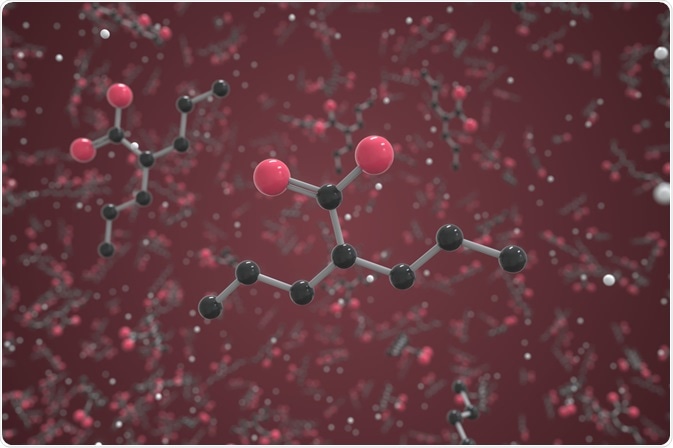Valproic acid is an antiepileptic drug that is commonly used in conjunction with other pharmaceutical therapies, which has the potential to lead to interactions between the drugs. This occurs relatively frequently due to the extensive metabolism of valproic acid in the body that is easily affected by, and can easily affect, the metabolism of other drugs.
 Valproic acid. Image Credit: Irina Anosova/Shutterstock.com
Valproic acid. Image Credit: Irina Anosova/Shutterstock.com
The following medications may all interact with valproate in the body and change the effect of one of both of the drugs.
- Aspirin
- Carbamazepine
- Chloroquine
- Cimetidine
- Colestyramine
- Erythromycin
- Felbamate
- Lamotrigine
- Mefloquine
- Olanzapine
- Phenobarbital
- Phenytoin
- Primidone
- Rifampicin
- Temozolomide
- Topiramate
- Warfarin
- Zidovudine
Each of these drugs may interact with valproate via varying mechanisms. The most commonly seen interactions seen in practice are described in more detail below.
Enzyme-inducing antiepileptic drugs
Other antiepileptic medications such as carbamazepine, phenobarbital, primidone and phenytoin are able to induce the enzymes needed to metabolize valproate. As a result, the clearance of valproic acid from the body is higher than usual and the available concentration in the bloodstream to exert the desired effect is lessened.
To manage this interaction, it is recommended to significantly increase the dose of valproate, often doubling the initial dose, to maintain the desired effect. In this way, even when the metabolism is increased, there remains enough valproate in the bloodstream to continue working sufficiently.
Valproic acid induction of enzymes
Whilst valproic acid is not known to induce enzymatic metabolism of other drugs, it is associated with a metabolic inhibition effect. This can results in higher than usual doses of other medications, such as phenobarbital and the metabolite of carbamazepine.
In order to manage this reaction, the standard response is to lower the dose of the other medication. This will decrease the concentration of drugs in the body and produce a net desired effect.
Displacement of proteins
Both valproic acid and phenytoin are highly protein-bound drugs in the circulatory system that is responsible for their distinctive volume of distribution. As a result, when these drugs are co-administered, the free fraction of phenytoin increases substantially, leading to a higher concentration and distinct pharmacological effect.
For this reason, toxicity and adverse effects are more likely to present when normal therapeutic doses are given. Instead, doses should be reduced to account for this reaction.
Anticoagulant medications
Sodium valproate can have an effect on the ability of the blood to form clots and stop bleeding. This can present as a particular issue when patients are taking other medications to regulate the platelets or coagulation factors in their blood.
For example, warfarin is an anticoagulant medication utilized in the prevention of embolism in the blood. It has a direct effect on coagulation factors in circulation and must be monitored closely to maintain the optimal concentration and pharmacological effect. Co-administration with valproate could affect this balance and result in severe consequences, such as incessant bleeding.
Additionally, aspirin is known to increase the concentration of valproic acid, which could potentially lead to toxicity and increased side effects. To manage this, it is recommended to reduce to the dose of valproic acid.
References
Further Reading